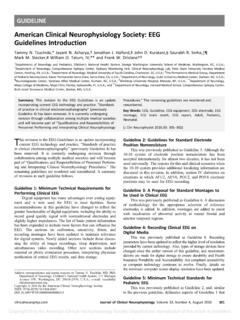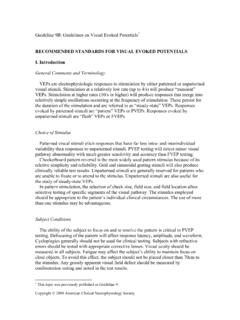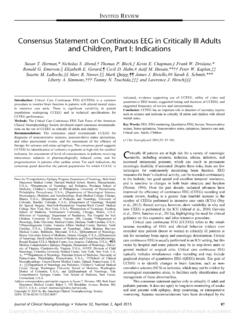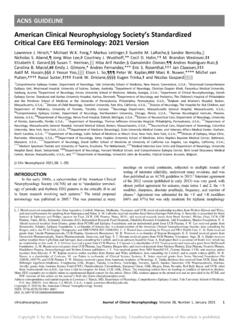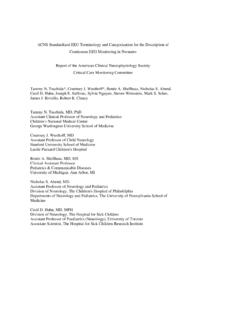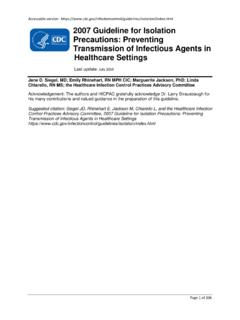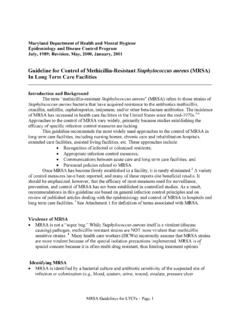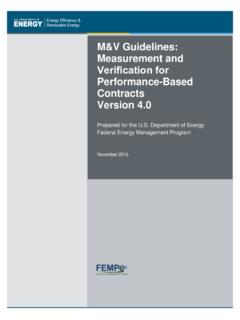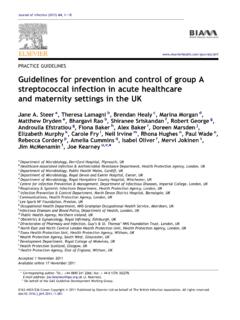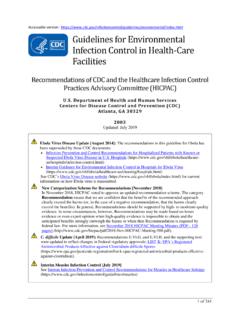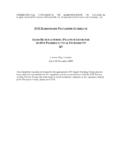Transcription of Guideline Eleven: Guidelines for Intraoperative
1 Guideline 11B: RECOMMENDED STANDARDS FOR Intraoperative MONITORING. OF SOMATOSENSORY EVOKED POTENTIALS. Somatosensory evoked potentials (SSEPs) can be used intraoperatively to assess the function of the somatosensory pathways during surgical procedures in which the spinal cord, brainstem, or cerebrum is at risk and to localize the sensorimotor cortex.(Jones, Edgar et al. 1983; Lueders, Lesser et al. 1983; Emerson and Adams 2003). A. General Requirements 1. Terminology Waveforms should be named as described in Guideline 9D.(ACNS 2006). 2. Stimulus and Safety A constant current stimulator is recommended for use in the operating room. Care should be exercised to prevent blood or other fluid from contaminating the stimulating site. Either standard disk electroencephalography (EEG) electrodes or sterile subdermal needle electrodes may be used.
2 Disk EEG electrodes should be applied to the scalp with collodion and sealed with plastic tape or sheet to prevent drying and to protect them from blood or other fluids. Contact impedance for disk electrodes should be less than 5 Kohms. Subdermal needle electrodes should be similarly secured; it is important that OR personnel be made aware of the use of locations of needle electrodes, so that they may observe necessary caution to avoid needle sticks. a. Stimulus Isolation and Subject Grounding The stimulation unit must be isolated from the main portion of the stimulator circuitry to avoid a large current flow to the patient in the case of stimulator malfunction. Commercial somatosensory stimulators designed for human use contain appropriate isolation circuitry. The ground may be placed on the limb that is stimulated to minimize the stimulus artifact.
3 B. Stimulus Parameters Monophasic rectangular pulses of 100-300 s duration and 30-40 mA intensity are recommended for stimulation of peripheral nerves. Failure of stimulation may occur when there is a significant increase in contact impedance or due to the development of a salt bridge, such as when excessive electrode paste short circuits the two stimulating electrodes. However, at times stimulation may fail due to patient related factors such as limb edema, peripheral neuropathy, or variant anatomy. Before increasing current levels to intensity above 30-40 mA, stimulating electrodes should be carefully evaluated. B. Neurophysiologic Intraoperative Monitoring of the Spinal Cord The risk of neurologic deficit resulting from spinal cord damage is in cases of instrumentation for scoliosis.
4 (MacEwen, Bunnell et al. 1975; Nuwer, Dawson et al. 1995; Coe, Arlet et al. 2006) In cases of surgical decompression for spinal cord tumors or trauma, the risk increases to about 20%. Surgery on the descending thoracic aorta exposes patients to the highest risk of injury to the spinal cord, with the incidence of paraplegia approaching 40%.(Husain, Ashton et al. 2008). Copyright October 2009 American Clinical Neurophysiology Society Monitoring of SSEPs directly assesses the function of the dorsal columns and may serve as a surrogate marker for global spinal cord function. Although there is good correlation between preservation of SSEPs and normal motor function, there are reported cases of postoperative paraplegia with preserved Intraoperative SSEPs.(Ben-David, Haller et al.)
5 1987; Nuwer, Dawson et al. 1995; Minahan, Sepkuty et al. 2001) Preservation of SSEPs does not guarantee preservation of motor function. For this reason, motor evoked potential (MEP) monitoring, which assesses the motor pathways in the ventral aspect of the spinal cord, may be conducted simultaneously with SSEP monitoring. The selection of the nerve to be stimulated to obtain the SSEP is determined by the segmental level of the surgical procedure. Spinal cord surgery above the C6 level can be monitored by SSEPs to median nerve stimulation. Ulnar nerve SSEP monitoring can be used when the surgery involves the lower cervical segments (above C8). Surgery involving levels below the C8 segment requires monitoring of SSEPs to stimulation of the posterior tibial or common peroneal nerve.
6 Other smaller nerves are used less often as their SSEPs are smaller in amplitude and harder to reproduce. 1. Monitoring of Cervical Spinal Cord NIOM for surgeries during which the cervical spinal cord is at risk involve SSEP monitoring with stimulation of the ulnar or median nerve. The median nerve is utilized if the surgery is above the level of C6. For surgeries below this level and above C8, the ulnar nerve can be used. a. Stimulation 1. Placement of stimulating electrodes When the median nerve is stimulated for SSEP monitoring, the cathode should be placed between the tendons of the palmaris longus and the flexor carpi radialis muscles, 2 cm proximal to the wrist crease. The anode should be placed 2-3 cm distal to the cathode or on the dorsal surface of the wrist.
7 Either surface disk electrodes or subdermal needle electrodes may be used. 2. Subject grounding A plate electrode on the palmar surface of the forearm or a band electrode around the forearm should be used as the ground electrode. 3. Stimulation rate A repetition rate of 2-8/s is suggested when obtaining SSEP for NIOM. A higher stimulation rate, up to 20/s, may be useful in certain instances to increase the speed monitoring. However, high stimulation rates can also result in lower amplitudes of the responses, thus increasing the amount of time needed to obtain a reproducible response. Stimulus rates must be optimized to obtain reliable responses in the shortest time possible. Stimulus rates that are multiples of the line current frequency (60 Hz in the North America) should be avoided, and fine adjustments of stimulus frequency often helps to eliminate line noise artifact from recordings.
8 4. Side of stimulation Copyright October 2009 American Clinical Neurophysiology Society SSEPs are obtained following unilateral median or ulnar nerve stimulation. Most current equipment permits right and left stimulation to be interleaved, with independent right and left SSEP recording being obtained currently. This helps in obtaining responses quicker. b. Recording The recording technique is the same whether median or the ulnar nerves are stimulated. A multi- channel recording is suggested. In the operating room environment, technical problems may occur in one or more channels. If problems occur with some channels, it is important to have additional channels for backup to allow monitoring to continue. Recording both subcortical and cortical SSEPs increases reliability.
9 (Emerson and Adams 2003) Cortical SSEPs are near-field, short latency EPs recorded from the scalp over the underlying sensory cortex using bipolar scalp-to-scalp electrode derivations. Subcortical SSEPs are near-field EPs recorded using scalp-to-noncephalic electrode derivations.(ACNS 2006). 1. System bandpass System bandpass of 30 1 kHz (-3db) is used most often. A lower low pass filter does not usually meaningfully enhance the recorded waveforms and often adds to recorded noise. A. higher high pass filter may be useful if one is relying primarily of the P14 subcortical component for monitoring. Filter settings should generally be kept constant during a monitored procedure. Changes in filter settings will cause changes in the responses that can erroneously be attributed to pharmacologic or surgical factors.
10 If filter setting are changed, it is important that baselines be reestablished. 2. Analysis time An analysis time of 50 ms is typical. The analysis time should be at least twice the usual latency of the last waveform of interest. Thus, in a median or ulnar nerve SSEP, the last waveform of interest is the N20; consequently the analysis for an upper limb study should be at least 40-50 ms. 3. Number of repetitions to be averaged A sufficient number of repetitions must be averaged to produce an interpretable and reproducible SSEP. Generally 250 1000 repetitions are needed; the number of repetitions depends on the amount of noise present and the amplitude of the SSEP signal itself (signal to noise ratio). In general, it is not desirable to average more than the number of necessary repetitions as this may delay feedback to the surgeon.
